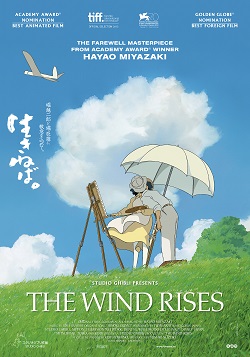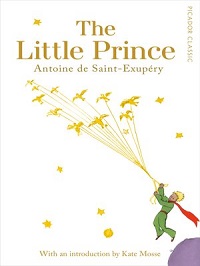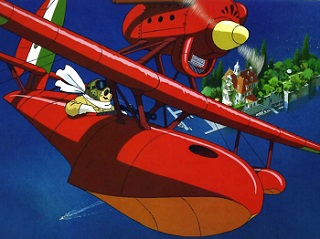 This animated film written and directed by Hayao Miyazaki is a story of a Japanese aircraft designer Jiro Horikoshi (1903-1982). The story also draws upon elements of the life of Japanese novelist Tatsuo Hori (1904-1953) and his autobiographical novel of the same name, The Wind Rises. The movie is Miyazaki’s tribute to Horikoshi and Hori who lived in a difficult time in Japanese history and presumably had a strong impact on Miyazaki. Although the movie is not a biography of either individual, it captures the essence of their lives. Also, the film is Miyazaki’s answer to a question of his fans as well as perhaps of his own regarding why he is attracted to war machines such as fighter planes, tanks, and firearms even though he is unquestionably a pacifist and abhors war. He succeeded in convincingly answering the question with this very moving film. Personally, this film stands out as the best among the movies created by Miyazaki even though its animation might not be as impressive as some of his previous works.
This animated film written and directed by Hayao Miyazaki is a story of a Japanese aircraft designer Jiro Horikoshi (1903-1982). The story also draws upon elements of the life of Japanese novelist Tatsuo Hori (1904-1953) and his autobiographical novel of the same name, The Wind Rises. The movie is Miyazaki’s tribute to Horikoshi and Hori who lived in a difficult time in Japanese history and presumably had a strong impact on Miyazaki. Although the movie is not a biography of either individual, it captures the essence of their lives. Also, the film is Miyazaki’s answer to a question of his fans as well as perhaps of his own regarding why he is attracted to war machines such as fighter planes, tanks, and firearms even though he is unquestionably a pacifist and abhors war. He succeeded in convincingly answering the question with this very moving film. Personally, this film stands out as the best among the movies created by Miyazaki even though its animation might not be as impressive as some of his previous works.
Early aviation as a quintessential part of the Belle Epoque and its ending
The Belle Epoque (the Beautiful Era) refers to the period of 40-50 years before World War I (WWI) when Europe and other advanced nations enjoyed a relatively peaceful period and an accelerating industrial revolution with an explosive progress of technology such as expansion of railroad network, development of electric power grids, telephone (1876), phonograph (1877), electric light (1880), Eifel Tower and World Fair in Paris (1889), radio (1897), gigantic steel ocean liners, skyscrapers, an airplane (1905), and mass production of automobiles (Ford Model T, 1908). These developments continuously impacted people’s way of living not only for the rich but also for the entire society. Of course, there existed serious social issues such as a huge income disparity and a cruel treatment of workers by employers. However, during the Belle Epoque, there was a prevailing feeling of optimism, empowerment of individuals and enrichment of their life; in other words, there was a feeling that things would continue to become better year after year.
Horikoshi grew up during the final decade of the Belle Epoque, witnessing astonishing development in aviation technology. That was a time when humans started flying like a bird for the first time in their entire history. With this backdrop, it is not surprising Horikoshi was fascinated by a machine that flies and wanted to pursue creating it.  It is worth noting that Antoine de Saint-Exupery (1900- 1944), the author of an all-time bestselling book, The Little Prince was a contemporary of Horikoshi. Saint-Exupery was also captivated by the development of aviation and was one of the pioneer aviators. In his great essays such as Terre des Hommes (meaning “Earth of Humans,” or English title Wind, Sand and Stars), he vividly describes his awe-inspiring experience, frightening dangers, and the spiritual and philosophical enlightenment brought to him by flying an airplane. Flying like a bird took him to the places no humans had ever been, and he saw things no humans had ever seen. Flying was an experience that changed how he viewed the world.
It is worth noting that Antoine de Saint-Exupery (1900- 1944), the author of an all-time bestselling book, The Little Prince was a contemporary of Horikoshi. Saint-Exupery was also captivated by the development of aviation and was one of the pioneer aviators. In his great essays such as Terre des Hommes (meaning “Earth of Humans,” or English title Wind, Sand and Stars), he vividly describes his awe-inspiring experience, frightening dangers, and the spiritual and philosophical enlightenment brought to him by flying an airplane. Flying like a bird took him to the places no humans had ever been, and he saw things no humans had ever seen. Flying was an experience that changed how he viewed the world.
Although WWI further accelerated the advancement of technology of the Belle Epoque, ironically the advancement of technology during WWI brought an end to the Belle Epoque. With the advances in weaponry, an unprecedented number of soldiers, 6 million, were killed in the war. A battle ground was no longer a place for heroes to shine. It turned to a killing field of horror. The term “shell shock” was born during the war, although it took many years before the condition currently known as post-traumatic stress disorder to be recognized as a serious mental condition that requires medical treatment. Instead, soldiers with shell shock were often regarded as cowards to be punished. During WWI, airplanes also developed into a powerful and deadly new weapon. Since then, the arms race has been the leading force of innovation in aircraft design. Horikoshi, as a talented and dedicated engineer, led a team designing fighter planes in his early career. This was a pursuit of creating the most advanced aircraft of the time that employed the newest available technologies. This was an endeavor almost like artists pursuing to create a masterpiece with a revolutionary approach. However, his effort turned to a tragedy once a war had broken out.
 Miyazaki himself was drawn to the beauty and danger of early aviation. Porco Rosso (1992) by Miyazaki was a comical and entertaining animated movie, but elements that were fully developed later in The Wind Rises were already present in this earlier work: heroism and excitement of early aviators and aircraft designers, the beauty and danger of flying in the sky in an airplane, and the tragic nature of airplanes as killing machines in war. Like Miyazaki, I also had a fascination toward airplanes, especially fighter planes, when I was a child. Warplanes, with their pursuit of maximum functionality, radiated a beauty in their form, whereas commercial planes with their focus on economy did not possess an awe the warplanes had. This attraction of warplanes is like looking at a beautiful art, and is not diminished by the knowledge that it is a killing machine.
Miyazaki himself was drawn to the beauty and danger of early aviation. Porco Rosso (1992) by Miyazaki was a comical and entertaining animated movie, but elements that were fully developed later in The Wind Rises were already present in this earlier work: heroism and excitement of early aviators and aircraft designers, the beauty and danger of flying in the sky in an airplane, and the tragic nature of airplanes as killing machines in war. Like Miyazaki, I also had a fascination toward airplanes, especially fighter planes, when I was a child. Warplanes, with their pursuit of maximum functionality, radiated a beauty in their form, whereas commercial planes with their focus on economy did not possess an awe the warplanes had. This attraction of warplanes is like looking at a beautiful art, and is not diminished by the knowledge that it is a killing machine.
Story of love and death
In this movie, the story of a heroic pursuit of aircraft design of Horikoshi was merged with the story of love and death of Tatsuo Hori. Tuberculosis was a leading cause of premature death in Japan before World War II (WWII). Hori himself contracted tuberculosis, and his fiancée died young from tuberculosis, as in the movie. The shadow of death constantly reminded Hori of the fleeting nature of his life and love. Blending these two stories in one was surprisingly successful, enhancing each other and adding a depth to the story. The film became more than either a story of a nerdy workaholic or the tragedy of dying young. It was not an easy time to live; many things that profoundly affected their lives were beyond their control, but everyone in the movie did what each of them could do without making excuses. They loved each other, helped each other, and pursued their passion. Even imminent death did not prevent the heroine from living fully.
The Post Belle Epoque, the time we all live in
During and after WWI, technology kept advancing at a brazen speed. However, the optimism during the Belle Epoque toward the advancement of science and technology was forever lost. The unprecedented casualties and cruelty of WWI made people start wondering if we became too good at killing each other, although it took the even greater death tolls in WWII and the invention of atomic bomb for people to start seriously searching for a way to avoid all-out wars between nations. Since WWII, advancements in technology continued: tuberculosis is no more a leading cause of premature death due to the discovery of antibiotics; jumbo jetliners greatly reduced time for long-distance travels; the computer and Internet revolution forever changed the way we work and live; sophistication of weaponry using the GPS technology was supposed to reduce war casualty by allowing precision bombing.
 The advanced weapons may have defeated oppressive dictatorships in the 21st century, but advanced weapons were unable to instill democracy and improve the life of people, and victims of civil wars have been piling up. Advanced technology cannot solve everything, but it has strong effects upon us for better or for worse. We should not forget a lesson learned from the tens of millions of war victims and the horror of the Cold War resulting from the technological advancement of weaponry. Another consequence of the progress of technology is a greatly increased impact of human activities on the environment. Throughout the entire human history preceding the Belle Epoque, Mother Nature was big enough and forgiving even though we little humans messed with Her. But this is no longer the case with our advanced technology and increased population. Although what we are doing to the environment won’t change it tomorrow or a few years later, it is our responsibility not to cause a great harm to the lives of the next generation.
The advanced weapons may have defeated oppressive dictatorships in the 21st century, but advanced weapons were unable to instill democracy and improve the life of people, and victims of civil wars have been piling up. Advanced technology cannot solve everything, but it has strong effects upon us for better or for worse. We should not forget a lesson learned from the tens of millions of war victims and the horror of the Cold War resulting from the technological advancement of weaponry. Another consequence of the progress of technology is a greatly increased impact of human activities on the environment. Throughout the entire human history preceding the Belle Epoque, Mother Nature was big enough and forgiving even though we little humans messed with Her. But this is no longer the case with our advanced technology and increased population. Although what we are doing to the environment won’t change it tomorrow or a few years later, it is our responsibility not to cause a great harm to the lives of the next generation.
A heroic effort of Horikoshi to advance technology did not contribute to the betterment of the society. This is the time we all live in. In the Post Belle Epoque, our future is anything but certain. Advancement of technology will continue, but there is no guarantee that it will make our life better. Because we cannot erase what we already know, we need to be wise to decide what to do with the powerful technology we have. The movie doesn’t provide a solution. Neither do we have one. The Wind Rises is not a movie just for aircraft enthusiasts or people who are interested in Japanese history. It presents a universal problem the technological advancement has created, and everyone is facing now.
